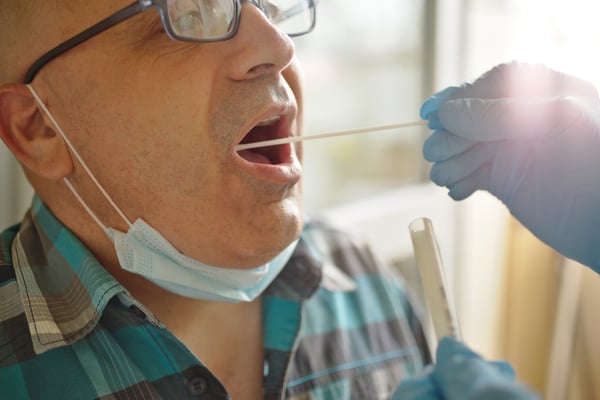
When a sore throat becomes worrisome, identifying the source of the problem will require the collection of a throat specimen by your practitioner. This will be the easiest and most reliable means of determining if an infection is the cause and, if present if the infection is bacterial or viral.
The practitioner knows the proper technique to carefully collect a throat swab that will ensure the specimen is ample in one attempt, and one that will yield reliable results. While medical training is needed for this step, selecting the correct swab simply takes an understanding of the swabs available and the properties of each.
How is a throat swab culture used?
For your practitioner, the goal is to get a quality specimen that will then go to the lab for assay. The test results will guide the practitioner in prescribing the best course of action to remedy the discomfort caused by the sore throat and/or infection and make you well. When selecting the product for specimen collection, there are options. But remember, for diagnostics, choose a synthetic tip material and a synthetic handle when selecting a specimen collection swab.
Types of swabs and handle materials
At Puritan, our swabs are designed to collect the highest quality diagnostic specimens. Within our range of swab products, swab tips come in many shapes and sizes, and are manufactured utilizing materials ranging from the traditional and familiar to the newest and most efficient. Within our range of swab products, swabs can be ordered in a number of materials, including:
- Spun fibers
- Cotton
- Calcium Alginate
- Rayon
- Polyester
- Foam and Flock (polyester fiber)
- PurFlock Ultra®
- HydraFlock®
Among those listed are two natural materials, cotton and calcium alginate, so set those aside when choosing a throat swab.
Puritan’s patented PurFlock Ultra® swab tips are manufactured with multi-length polyester fibers that assure efficient specimen collection and complete release. Puritan’s patented HydraFlock® swabs tips of the same material feature split end fibers that provide more surface area and even greater collection capacity. With these flock swabs, the practitioner will collect a superior specimen with optimum patient comfort and deliver it to the lab for processing, confident the results will be reliable.
As for handle lengths, though 3” and 6” medical swabs are produced, when collecting a throat swab, 6” handles are commonly used. Swab handles may be of wood, polystyrene, aluminum, polypropylene, or nylon.
Identifying the right pairing of materials is important to getting the right throat culture. You can fine-tune your selection – consider available throat swab devices and collection kits.
What is a throat swab collection device?
When you select a transport media system for your throat specimen collection, you will have these components in one device:
- Swab
- Tube
- Cap
- Sterile medium
You'll want a system that includes a leak-proof self-centering cap, and a high-performance flocked swab with a molded breakpoint. A well-designed liquid Amies transport system includes everything you need to quickly and easily collect any bacterial specimen. Puritan’s Opti-Swab®, specifically designed for the collection and transport of clinically significant bacteria, is the ideal choice for specimen transport to the lab while maintaining bacterial integrity. And it’s fast, safe, and convenient for you to use.
For viral specimen collection, consider Puritan’s UniTranz-RT®. This family of universal transport media devices is offered with flock swabs or spun polyester tipped swabs, to address a range of collection sites and specimens. The medium is formulated to reliably transport viral specimens to the lab.
What is a throat swab used to test for?
Throat swabs are used to test for the following:
Strep throat
Streptococcal pharyngitis, also known as strep throat, is a common contagious bacterial infection that causes throat soreness, enlarged lymph nodes, and fever. There are a few ways you can test for strep throat, but the most common is by using a throat culture swab. You simply take the swab and rub it over the back of the throat wall and tonsils to get a bacteria sample. The sample is then tested in a laboratory to identify what bacteria are present.
Flu
Influenza, also known as the flu, is a common and highly contagious infection that affects the lungs, nose, and throat. Symptoms may include cough, chills, fever, nausea, and more. Flu tests typically use a respiratory sample taken from the nose or throat in order to determine if the flu virus is present in your body’s mucus.
COVID-19
We are all keenly aware of the effects of Coronavirus, also known as COVID-19, these days, but we’ll overview what it is for consistency. COVID-19 is a respiratory virus that is often classified as a more intense version of the flu, given that many symptoms overlap. However, COVID-19 also includes loss of taste or smell for extended periods of time, which is unique to the virus. When testing for COVID-19, you typically use a swab to collect a nasopharyngeal or nasal specimen and in some cases, an oropharyngeal specimen from your nose or mouth to identify the presence of the virus.
Tonsillitis
Tonsil inflammation, also known as tonsillitis, is a viral infection that causes inflammation of the tonsils. Since many symptoms are throat-related (difficulty swallowing, swollen lymph nodes, sore throat), you can typically test for tonsillitis by swabbing the back of the throat.
How to Collect a Throat Swab Specimen to Culture for Testing [VIDEO]
To make your throat swab culture collection much simpler, we are sharing a step-by-step tutorial to follow from start to finish.
We’ve also listed out all of the steps in the video below for you to easily reference next time you take a throat swab specimen.
Step-by-Step Guide to Collecting a Throat Swab Specimen
- Wash hands thoroughly and quickly put on gloves, a surgical mask, and protective eye-wear following your handwashing
- Have the patient face a bright light to ensure the swab surface (the throat) is easily visible
- Open the package containing the HydraFlock® flocked swab and remove the swab from packaging, while maintaining sterilization
- Have the patient tilt their head backwards, open their mouth, and stick out their tongue
- Use a wooden tongue depressor to hold the tongue in place
- Without touching the sides of the mouth, use the sterile HydraFlock® flocked swab to brush the the posterior nasopharynx and the tonsillar arches
- After you’re finished, insert the swab into sterile liquid Amies for bacterial or UniTranz for viral needs
- Break the swab handle at scored breakpoint line (you’ll see it on the packaging)
- Replace the cap and tighten it to secure
- Remove and dispose of your gloves and mask
- Label the vial with appropriate information (e.g., patient name)
- Deliver samples to the laboratory for testing
The best swab type for throat swabbing
As you consider which swab type is best for your throat swabbing needs, evaluating the various types and the recommended use of each is an important step. The truth is, there is no one-size-fits-all solution, so you’ll need to evaluate the materials included within a throat culture swab test kit as they relate to your specific needs. Consider these five types of swabs as you look to purchase your throat swab kits:
Cotton
The most commonly known type of swab is undoubtedly the cotton swab. Because it’s low cost, absorbent, and safe to use, medical professionals have been turning to the cotton tipped swab for decades. However, it’s not actually recommended for specimen capture for two key reasons: 1) cotton absorbs and traps the specimen, making it hard to test, and 2) natural fibers of cotton interfere with microbial processes.
Foam
Used in diagnostics first and foremost, foam tipped swabs come in a variety of shapes and sizes, making it a highly customizable type of swab.
Rayon
Made of natural materials (wood pulp) spun rayon fiber is denatured, converting it into a synthetic material. As such, it does not interfere with the specimen once it’s been collected, making it a good choice for diagnostic testing. However, this fiber performs like cotton, entrapping the specimen and making it hard to extract. When there is ample specimen available, rayon is economical and works well.
Polyester
Similar to cotton, polyester is a synthetic spun fiber material ideal for swab manufacture. It’s considered the next level up when it comes to specimen collection. Coming in at a more costly price than cotton or rayon, polyester releases well and is a top-notch option for specimen collection related to microbiology, rapid diagnostic tests, and PCR analysis.
Flocked
Flocked swabs are recommended for flu testing by the American Society for Microbiology specifically because they best collect and elute more specimen than traditional spun fiber or foam swabs. How is that? The fiber tip of the flock swab has a higher surface area, allowing for a greater volume of specimen collected. Plus, they also are known to be user-friendly and to cause minimal patient discomfort during the swabbing process.
>> Crafting perfection for your requirements - Puritan Medical Products offers premier custom swab manufacturing services. Elevate your medical devices with precision engineering.
Make the best possible swab purchasing decision for your business by utilizing our experts.
As always, if you have any questions about which Puritan products to choose for throat swabs or bacterial collection and transport, please contact a knowledgeable product specialist today –our experts are standing by during normal business hours to help.





